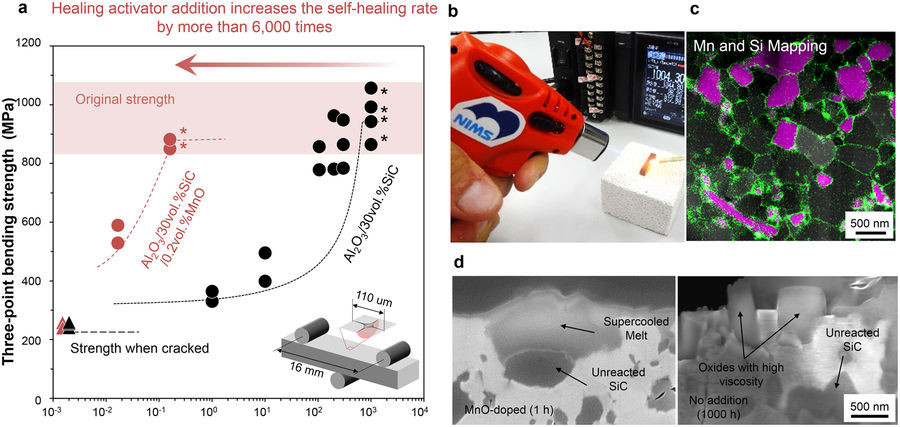3D治癒活性相ネットワークを用いるき裂自己治癒構造セラミックスの新規設計アプローチ
A Novel Design Approach for Self-Crack-Healing Structural Ceramics with 3D Networks of Healing Activator
2017年12月19日 Scientific Reports 7 : 17853 doi: 10.1038/s41598-017-17942-6

事前に導入した治癒エージェントの酸化によるき裂自己治癒は、航空機エンジンのタービン翼といった安全要求が厳しい部材用の高温構造セラミックスに不可欠な特性である。今回我々は、治癒機構の解明で得た知見に基づき、治癒活性相の3Dネットワークを取り入れる新しい自己治癒設計アプローチについて報告する。我々は、適切な熱力学計算によって選定した少量の活性剤を添加する(代表例としては、ドープMnOをき裂経路に局在化させる)ことによって、治癒速度が6000倍以上と大幅に加速され、必要反応温度が大幅に下がることを実証している。き裂経路の活性相は、移動性の過冷却融体を生成することによってき裂部を迅速に充填するため、酸素が治癒エージェントに効率よく運ばれる。さらに、活性相は、融体の結晶化を促進し、機械強度の高い治癒酸化物を形成する。また我々は、治癒機構が初期酸化段階の他に2つの段階からなることを解明できた。我々は、骨の治癒に基づき、これらの段階をそれぞれ炎症期、修復期、改変期と名付けた。今回の設計戦略を適用すれば、航空機エンジンの高圧もしくは低圧タービン翼に適した新しい軽量自己治癒セラミックスが開発可能である。
Corresponding Author
Self-crack-healing by oxidation of a pre-incorporated healing agent is an essential property of high-temperature structural ceramics for components with stringent safety requirements, such as turbine blades in aircraft engines. Here, we report a new approach for a self-healing design containing a 3D network of a healing activator, based on insight gained by clarifying the healing mechanism. We demonstrate that addition of a small amount of an activator, typically doped MnO localised on the fracture path, selected by appropriate thermodynamic calculation significantly accelerates healing by >6,000 times and significantly lowers the required reaction temperature. The activator on the fracture path exhibits rapid fracture-gap filling by generation of mobile supercooled melts, thus enabling efficient oxygen delivery to the healing agent. Furthermore, the activator promotes crystallisation of the melts and forms a mechanically strong healing oxide. We also clarified that the healing mechanism could be divided to the initial oxidation and additional two stages. Based on bone healing, we here named these stages as inflammation, repair, and remodelling stages, respectively. Our design strategy can be applied to develop new lightweight, self-healing ceramics suitable for use in high- or low-pressure turbine blades in aircraft engines.

